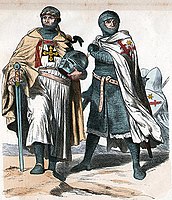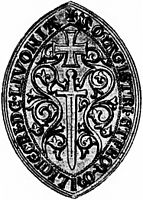Livonia
This article needs additional citations for verification. (June 2008) |
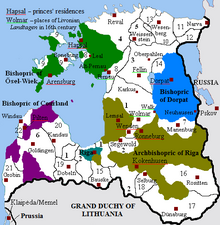

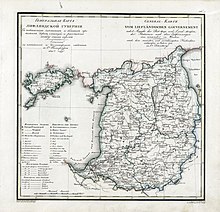
Livonia[a] or in earlier records Livland,[1] is a historical region on the eastern shores of the Baltic Sea. It is named after the Livonians, who lived on the shores of present-day Latvia.
By the end of the 13th century, the name was extended to most of present-day Estonia and Latvia, which the Livonian Brothers of the Sword had conquered during the Livonian Crusade (1193–1290). Medieval Livonia, or Terra Mariana, reached its greatest extent after the Saint George's Night Uprising of 1343-1345, which forced Denmark to sell the Duchy of Estonia (northern Estonia conquered by Denmark in the 13th century) to the State of the Teutonic Order in 1346. Livonia, as understood after the retreat of Denmark in 1346, bordered on the Gulf of Finland in the north, Lake Peipus and Russia to the east, and Lithuania to the south.
As a consequence of the 1558–1583 Livonian War, the territory of Livonia was reduced to the southern half of Estonia and the northern half of Latvia.
The indigenous inhabitants of Livonia were various
History
Beginning in the 12th century CE, Livonia became a target for economic and political expansion by
Livonian Brothers of the Sword 1204–1237
Bishop
-
Baltic Tribes, ca 1200.
-
Teutonic Knight and Livonian Brother
-
Seal of the Livonian Brothers
Livonian Crusade 1198–1227
The
Monastic state of the Teutonic Knights 1237–1561
Livonia consisted of the following subdivisions:
- a state ruled by the Teutonic Knightsin 1237);
- the Bishopric of Riga (an archbishopric from 1255);
- the Bishoprics of Ösel-Wiek, and Dorpat, where Albert's brother Hermann established himself as the prince-bishop (Terra Mariana).
The Livonian Rhymed Chronicle describes the conquest of Livonia by the Germans.
Livonian Order 1237–1561
The Livonian Order was a largely autonomous branch of the
In 1570, Tsar Ivan IV of Russia installed
From the 14th to the 16th centuries,
-
Livonian knight in 16th century
-
Livonian lady by Albrecht Dürer
Livonian Confederation 1418–1561
In 1418, the
A diet or Landtag was formed in 1419. The city of Walk was chosen as the site of the diet.Livonian War 1558–1583

Once
Shortly after that, Erik XIV quickly lost any allies that he was about to obtain, either in the form of Magnus or of the Archbishop of
Johan III, due to his friendship with Poland, began a policy against Muscovy. He would try to obtain more land in Livonia and to dominate Denmark. After all parties had been financially drained, Frederick II let his ally, King Sigismund II Augustus of Polish–Lithuanian Commonwealth, know that he was ready for peace. On 15 December 1570, the Treaty of Stettin concluded the Northern Seven Years' War.
It is, however, more difficult to estimate the scope and magnitude of the support Magnus received in Livonian cities.[citation needed] Compared to the Harrien-Wierland gentry, the Reval city council, and hence probably the majority of citizens, demonstrated a much more reserved attitude towards Denmark and towards King Magnus of Livonia. Nevertheless, there is no reason to speak about any strong pro-Swedish sentiments among the residents of Reval. The citizens who had fled to the Bishopric of Dorpat or had been deported to Muscovy hailed Magnus as their saviour until 1571. Analysis indicates that during the Livonian War a pro-independence wing emerged among the Livonian gentry and townspeople, forming the so-called "Peace Party".[citation needed] Dismissing hostilities, these forces perceived an agreement with Muscovy as a chance to escape the atrocities of war and to avoid the division of Livonia. Thus Magnus, who represented Denmark and later struck a deal with Ivan IV, proved a suitable figurehead for this faction.
The Peace Party, however, had its own armed forces – scattered bands of household troops (Hofleute) under diverse command, which only united in action in 1565 (Battle of Pärnu and Siege of Reval), in 1570–1571 (Siege of Reval; 30 weeks), and in 1574–1576 (first on Sweden's side, then came the sale of Ösel–Wiek to the Danish Crown, and the loss of territory to Tsardom of Russia). In 1575, after Muscovy attacked Danish claims in Livonia, Frederick II dropped out of the competition, as did the Holy Roman Emperor. After this Johan III held off on his pursuit for more land due to Muscovy obtaining lands that Sweden controlled. He used the next two years of truce to get in a better position. In 1578, he resumed the fight, not only for Livonia, but also for everywhere due to an understanding that he made with the Rzeczpospolita. In 1578, Magnus retired to the Rzeczpospolita and his brother all but gave up the land in Livonia.
Duchy of Livonia 1561–1621
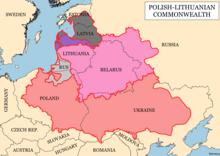

In 1561, during the Livonian War, Livonia fell to the Grand Duchy of Lithuania[6][7][8] and became a dependent vassal of Lithuania.[8] Eight years later, in 1569, when the Grand Duchy of Lithuania and the Kingdom of Poland formed the Polish–Lithuanian Commonwealth, Livonia became a joint domain administered directly by the king and grand duke.[6][8][9][10][11][12] Having rejected peace proposals from its enemies,
was divided onto:- Kieś)
- Dorpat)
- Parnawa)
Based on a guarantee by Sigismund II Augustus from the 1560s, the German language retained its official status.[3]
Kingdom of Livonia 1570–1578
The armies of
In the next phase of the conflict, in 1577, Ivan IV took advantage of the Commonwealth's internal strife (called the war against
Swedish Livonia 1629–1721
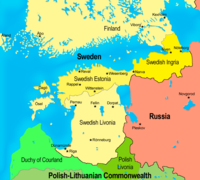
Livonian Voivodeship 1620s–1772

The Livonian Voivodeship (Lithuanian: Livonijos vaivadija; Polish: Województwo inflanckie) was a unit of administrative division and local government in the Duchy of Livonia, part of the Polish–Lithuanian Commonwealth, since it was formed in the 1620s out of the Wenden Voivodeship till the First Partition of Poland in 1772.
Riga Governorate 1721–1796

The Russian Empire conquered Swedish Livonia during the course of the Great Northern War and acquired the province in the Capitulation of Estonia and Livonia in 1710, confirmed by the Treaty of Nystad in 1721. Peter the Great confirmed German as the exclusive official language.[3] Russia then added Polish Livonia in 1772 during the Partitions of Poland.
Governorate of Livonia 1796–1918
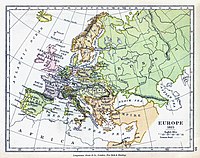
In 1796, the Riga Governorate was renamed as the Governorate of Livonia (Russian: Лифляндская губе́рния / Liflyandskaya guberniya, Latvian: Vidzemes guberņa, Estonian: Liivimaa kubermang). Livonia remained within the Russian Empire until the end of World War I, when it was split between the newly independent states of Latvia and Estonia. In 1918–1920, both Soviet troops and German Freikorps fought against Latvian and Estonian troops for control over Livonia, but their attempts were defeated.
Governors-General of Estonia, Livonia, and Courland 1845–1876
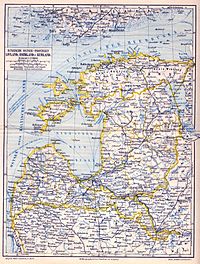
From 1845 to 1876, the Baltic governorates of
Vidzeme in Independent Latvia 1918–1940

In independent Latvia between the World Wars, southern Livonia became an administrative region under the traditional Latvian name Vidzeme, encompassing the then much larger counties of Riga, Cēsis, Valmiera, and Valka.
Ostland 1941–1944

Ostland was one of the Reichskommissariats established, by a Decree of the Führer dated 17 July 1941, as administrative units of the "Großdeutsches Reich" (Greater Germanic Reich). The structure of the Reichskommissariats was defined by the same decree. Local administration in the Reichskommissariats was to be organized under a "National Director" (Reichskomissar) in Estonia, a "General Director" in Latvia and a "General Adviser" in Lithuania. The local administration of the Reichskommissariat Ostland was under Reichskomissar Hinrich Lohse. Below him, there was an administrative hierarchy: a Generalkomissar led each Generalbezirke, Gebietskomissars and Hauptkommissars administered Kreigsbietes and Hauptgenbietes, respectively. Alfred Rosenberg's (Minister für die besetzten Ostgebiete (Reich Ministry for the Occupied Eastern Territories)) ministerial authority was, in practice, severely limited. The first reason was that many of the practicalities were commanded elsewhere: the Wehrmacht and the SS managed the military and security aspects, Fritz Sauckel (Reich Director of Labour) had control over manpower and working areas, Hermann Göring and Albert Speer had total management of economic aspects in the territories and the Reich postal service administered the East territories' postal services. These German central government interventions in the affairs of Ostland, overriding the appropriate ministries was known as "Sonderverwaltungen" (special administration). Later, from September, the civil administration that had been decreed in the previous July was actually set up. Lohse and, for that matter, Koch would not bow to his authority seeking to administer their territories with the independence and authority of gauleiters. On 1 April 1942, an arbeitsbereich (lit. "working sphere", a name for the party cadre organisation outside the reich proper) was established in the civil-administration part of the occupied Soviet territories, whereupon Koch and Lohse gradually ceased communication with him, preferring to deal directly with Hitler through Martin Bormann and the party chancellery. In the process, they also displaced all other actors including notably the SS, except in Central Belarus, where HSSPF Erich von dem Bach-Zelewski had a special command encompassing both military and civil administration territories and engaged in "anti-partisan" atrocities.
Baltic countries since 1990
The historical land of Livonia has been split between
See also
|
Further reading
- Les pays baltiques, le pluriculturalisme en héritage, Yves Plasseraud; Armeline, 2020.
- Les Germano-baltes, Yves Plasseraud; S. Pourchier-Plasseraud; Armeline, 2022.
Notes
References
- ^ a b Kropotkin, Peter Alexeivitch; Bealby, John Thomas (1911). "Livonia". Encyclopædia Britannica. Vol. 16 (11th ed.). pp. 816–817.
- ^ "Letter by Pope Gregory IX". Archived from the original on 14 August 2007.. In Latin. Hosted by the National Archive of Finland. See "Arkistolaitos - Sähköiset palvelut". Archived from the original on 8 June 2007. Retrieved 29 May 2007. and Diplomatarium Fennicum from the menu.
- ^ ISBN 3-11-017503-7.
- ISBN 0-313-32355-0; p. 23
- ^
Pihlajamäki, Heikki (2017). "The outset: The Livonian and Swedish Legal orders at the Time of the Swedish Conquest". Conquest and the Law in Swedish Livonia (ca. 1630–1710): A Case of Legal Pluralism in Early Modern Europe. The Northern World. Leiden: Brill. p. 24. ISBN 9789004331532. Retrieved 19 June 2020.
A division into five rival small principalities thus developed during the thirteenth century: the State of the Teutonic Order, the Archbishopric of Riga, the bishoprics of Dorpat, Oesel–Wiek and Courland. The five principalities formed the Livonian Confederation, the Ordenstaat, until its dissolution in 1561.
- ^ ISBN 9986-830-89-3.
- ISBN 0-521-28038-9.
- ^ ISBN 963-9116-42-4.
- ISBN 0-19-820171-0.
Livonia 1561.
- ^ George Miller (1832). "Modern History". History, philosophically illustrated, from the fall of the Roman empire to the French revolution. p. 258.
- OCLC 1535884.
- Beresford James Kidd (1933). The Counter-reformation, 1550–1600. Society for promoting Christian knowledge. p. 121.
- ^ Suvorov A.A. governor-general in 1861–66 :: ENCYCLOPAEDIA OF SAINT PETERSBURG
External links
- Virtual Livonia
- Deutsch-Baltische Ritterschaften in Livland, Kurland, Estland, Oesel (in German)
- Joann Portantiuse Liivimaa kaart 1573. aastast
- Estonian Manors Portal the English version includes the description of 438 well-preserved historical manors of nowadays Estonia (historically – northern part of Old-Livonia/Alt-Livland)
- Atlas of Livonia, or of the Two Governments and Duchies Livonia and Estonia, and of the Province of Oesel from the World Digital Library


